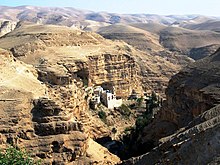Wadi Qelt

Wadi Qelt ( Arabic وادي القلط, DMG wādī al-qilṭ , also Deir el-Quelt, Deir el-Kelt; Hebrew נהל פרת, Nahal Prat) is a wadi with a course from west to east through the Judean Desert in the West Bank . The wadi, which has water all year round, has three sources: Ain Farah, Ain Fawar and Ain Qelt, which are east of Jerusalem . It ends at Jericho near the Dead Sea and is home to a unique variety of plants and animals.
After the occupation of the West Bank by Israel in 1967, parts of the wadi were declared a nature reserve of Nahal Prat Nature Reserve .
history
Several aqueducts have been found along the creek , the oldest from the Hasmonean era (2nd century BC). Herod had the aqueduct system expanded to provide Jericho with water all year round. During the British mandate , the system was restored.
The Greek Orthodox Monastery of St. George is located in Wadi Qelt . There are numerous Byzantine hermit cells in its vicinity .
At the entrance to Wadi Qelt near Jericho are the ruins of the royal winter palace of the Hasmoneans and Herod.
Web links
Coordinates: 31 ° 50 ′ 39.5 " N , 35 ° 24 ′ 51.3" E



